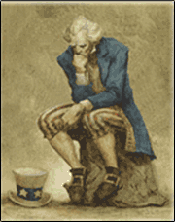Iran's mullahs try to spoil the annual Fire Feast – and Iranians ignore them
One of the favorite celebrations for the Iranian people is the Festival of Fire, which takes place on the eve of the last Wednesday before Nowruz.
It's a prelude to Nowruz, which is the Iranian new year, and the first day of spring, which begins on March 20.

Participants celebrate by jumping over bonfires and fireworks as a symbolic purification for the oncoming spring and the Persian New Year. People gather by the fire, jump over seven small piles of fire, and say to the fire, "give me your handsome red color and take back my unhealthiness."
The holiday is derived from the ancient Persian faith of Zoroastrianism, and there are many different traditions practiced on this night in different cities. One is the buying of a special mix of sweets and nuts, which is done in most cities. It's considered a fun activity and is done after the night's fire-jumping. It's similar to trick-or-treating in the West on Halloween night.
This year, however, is just a little bit different. On Sunday, two days ahead of the annual Fire Festival, the mullahs' supreme leader, Ali Khamenei, in response to an obviously made up and ridiculous question, said the Fire Festival "has no basis in our laws and it causes a lot of harm and corruption, therefore it must be banned."
But the people ignored this decree, and the Fire Feast was celebrated across the country anyway. The Iranian press reported:
In Tehran During recent days, firecrackers echoed across the city, and the state-run media continually broadcast the ridiculous fatwa of Khomeini and his affiliated mullahs on disapprobation of Fire Feast and calling it sinful. Police chief Hossein Ashtary threatened to seriously deal with the aggressors and violators of the people's rights. Tehran police Chief Hossein Sajedinia said: 'In case those who disturb the order cause inconvenience, the police will confront seriously.' (Tasnim News Agengy, March 14 )
Repressive forces had a dense presence with motorized patrols in the streets seeking to intensify the atmosphere of intimidation in the society Repressive forces, including state police and the so-called "Guidance" patrols were seen in various cities attempting to disperse the youth. However, people and the youth responded by ridiculing them and forcing these units to leave the scenes. (According to National Council of Resistance of Iran [NCRI])
A local eyewitness said, "In some part of Tehran, local police officers went door to door warning residents that large celebrations were banned." However, many neighborhoods "rocked" with bonfires and music later in the evening. The eyewitness said the slogan "Death to Khamenei; death to the principle of velayat-e faqih" was echoed throughout the city, with Khamenei's picture set ablaze. There were clashes with police. The repressive organs, making attacks during Fire Feast, were seen in different parts of Tehran.
It really did happen all over Iran.
In Mashhad, northeast of Tehran and the second most populous city in the country, as well as the capital of Razavi Khorasan Province, youths threw Molotov cocktails at the headquarters of the repressive Basij organ at Vakil Abad Boulevard. The youth of Shahr-e Kurd set up fire all across the city, tossed Molotov cocktails at police forces, and clashed with them.
In Isfahan, 340 kilometers south of Tehran, Iran's most populous metropolitan area, the sound of explosions could be heard all over the city.
In Baneh, people celebrated using grenades and firecrackers and fireworks. Repressive police forces did not get out of their vehicles for fear of the wrath of the youth.
In Tabriz, the most populous city in Iran's Azerbaijani region in the north, a vehicle carrying the repressive security forces was targeted by the youths' handmade grenades as well.
In Shahr-e-Kord, the youth put fire on everywhere in the city and started clashing with the security forces using gasoline bombs.
In Rasht, the largest city on Iran's Caspian Sea coast, people chanted, "Death to the dictator" and "This year is the year of Fire," burning the photos of Khomeini, thus forcing the regime's mercenaries to leave the scene. However, the regime's officials failed to hide the main cause of their fear in this national celebration. Saad, a member of the regime's parliament, said, 'The Fire Feast in recent years has turned from a traditional one to a dangerous ceremony."
One day after the celebration on March 15, Mohammad Sharafi, one of Iran's Security Forces' commanders, declared that the suppressive forces arrested almost 1,500 people during the Fire Festivities (state news agency of ISNA, March 15). These arrests indicate the authorities' fearful reaction to Iranian youths, who, despite all the regime's threatening warnings, turned the Fire Festivities into a scene of their confrontation with the despotic regime as well as an opportunity for expressing their revulsion of the regime.





